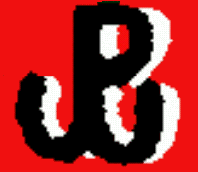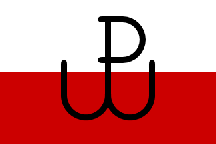Note: If an image ever fails to appear - refresh your page, it really is there
Polish Resistance to the German Occupation 1936-1945
by Chrystian Kretowicz and Peter Loeser
I noticed an absence of the unique symbols used during the Nazi occupation and especially during the Warsaw Uprising of August-September 1944. Although, the legal symbols used by the Polish Government in exile and by its delegation inside the occupied country were those of the Polish Republic, a distinctive symbol was used by the main resistance organization the AK (Home Army) and was extremely popular among the general population, particularly during the Uprising of 1944 when most of the city of Warsaw was liberated for a short period of time and that symbol appeared on flags being raised all over the city.
 Polish Resistance Symbol Polish Resistance Symbol This symbol, the combined letters "P" and "W" for "Polska Walczaca" (Fighting Poland), also representing an anchor, symbol of hope, were a common sight all over the country as the graffiti on the walls, defacements of German posters and on the arm bands of partisan units such as the Armia Krajowa (Home Army, or AK). It was created in 1942 by members of the AK Wawer (Small Sabotage) unit as an easiily usuable emblem for the Polish struggle to regain independence.
It is important to point out that no Poles served in the SS units, and that there were few Polish collaborators, except those motivated mostly out of greed or fear, and that their numbers were minuscule, comparing with other occupied countries. In fact, the Germans didn't have any desire to recruit them and there were no volunteers anyway. The recruitment was limited only to the "volksdeutches," who, by the definition, were no longer Poles (or Polish citizens) after signing the "volkslist." The drafting to the regular Wehrmacht of the Kashubians and Silesians was done on the assumption of them being "Germanic," which was, of course, just nonsense.
An interesting point here was that the grandfather of the current Polish Prime Minister, Donald Tusk, who is Kashubian, was drafted to the Wehrmacht in the Free City of Danzig (before the war a separate country, a protectorate of the League of Nations) and deserted promptly at the first opportunity few weeks later.
 Polish Underground Flag Polish Underground Flag The Polish Government-in-Exile (first in Paris, later in London) maintained a formidable administrative apparatus within the country through its Delagature, including the courts of justice, which meted appropriate punishments on the collaborators, mostly death sentences, which were then carried out by the resistance forces.
It also maintained an armed force, the largest guerrilla army in Europe, called the Home Army (Armia Krajowa), which is credited by the Western historians (Norman Davies and John Keegan, among others) with one of the deciding efforts in the collapse of the Third Reich, namely the destruction and disruption of the transportation routes to the Eastern Front. (I don't remember the exact tonnage destroyed, but it was enormous) Besides the Home Army (AK), there were the Bataliony Chlopskie (Peasant Battalions), an armed wing of the Polish Peasant's Party which were strategically allied with the Home Army, and the communist-oriented units of the People's Guard (GL), later People's Army (AL), and a right-wing force named the National Armed Forces (NSZ), together with the array of smaller armed organizations and including a regular Polish Army unit commanded by Major Henryk Dobrzanski, which never surrendered to the Germans or Soviets, and fought them both until June of 1940 as the first partisan outfit in Poland and Europe in World War II.
A look at the list of the "Righteous among the Nations" at Yad Vashem, discovers 6,135 Poles are listed there, by far the largest number of rescuers. In fact, it is estimated that tens of thousands of the Poles were executed by the Nazis solely for helping the Jews, some sources run that number up to 150,000. In German-occupied Poland, all household members were punished by death if a Jew was found concealed in their home or property. Death was a punishment for providing any aid to Jew, including giving bread or water to passing Jews. This was the most drastic measure in all of occupied Europe. The very few collaborators who denounced the Jews to the Germans, were mostly executed by the underground authorities or met their punishment right after the war.
In fairness, it should be mentioned that there was an early attempt by a tiny fascist movement called the "Falanga," led by Boleslaw Piasecki, to offer their services to the Germans, but, being rejected, they eventually joined the ranks of the resistance instead. Some Poles, especially Silesians and Kashubians, were forcibly drafted to the regular Wehrmacht, but most of them deserted at the first opportunity. The various Nazi attempts to "divide and rule," like the projects of creating mini-puppet states of Goralenvolk (Górale or Mountain People) and Kaschubenvolk, were total failures in Poland.
I hope this information might be of interest to both historians and vexillologists, because it is, for some strange reason, omitted in most Western historical resources.
| Top of Page | Learn More about the Evolution of the Polish Coat-of-Arms |
| Return to "Flags of the Third Reich" page | Return to "Historical Flags of Poland 1926 to 1999" page |
| Return to "Vexillological Essays and Chart Pages Menu" |
|